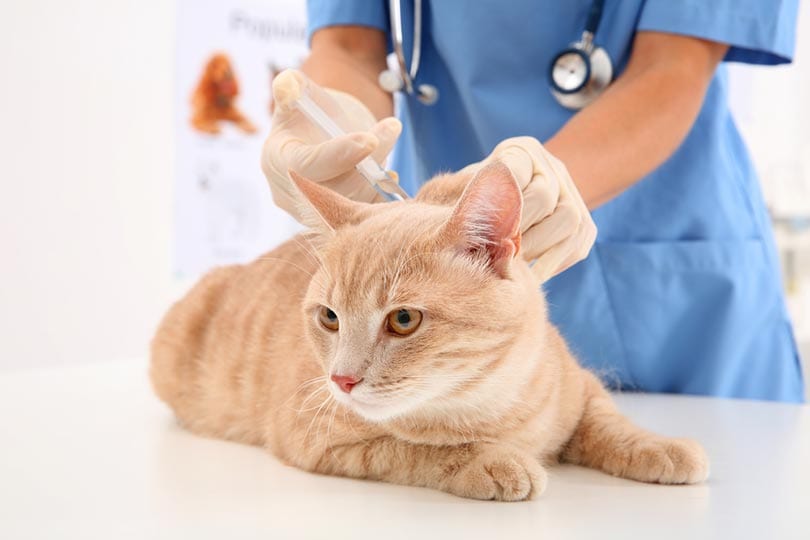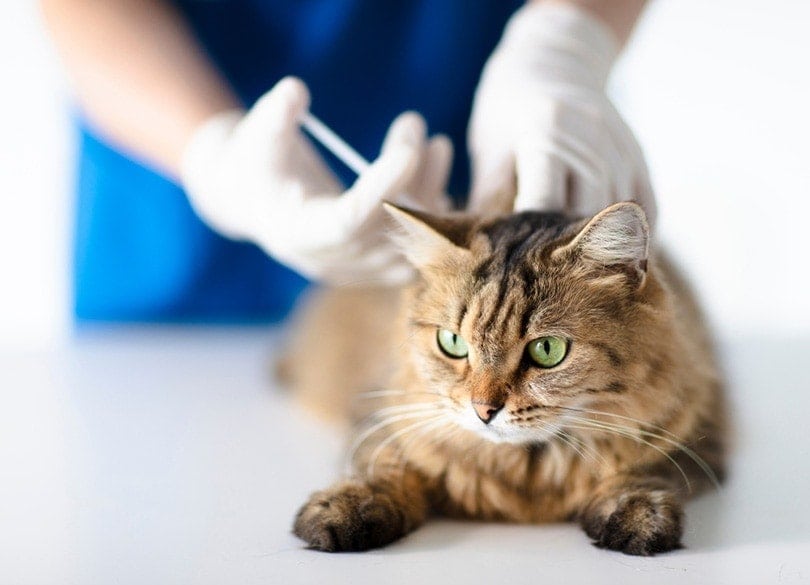VET APPROVED

The information is current and up-to-date in accordance with the latest veterinarian research.
Learn more »Click to Skip Ahead
When you think about rabies, the first thing that may come to mind is a clearly rabid dog foaming at the mouth. However, it’s not just canines that can contract rabies; all mammals can, including felines and humans.
Fortunately, people in the United States have an incredibly low chance of contracting rabies and are safer than ever before thanks to widespread vaccination programs.1 But even so, when some people see a stray cat roaming their neighborhood, they might automatically assume that the cat is rabid.
While it is true that rabies is found more often in cats than dogs in the United States, vaccines have still made this a rare occurrence. In fact, there were only 222 cases of rabies in cats noted by the U.S. National Rabies Surveillance System in 2022, which is the most recent data reported.2 Ultimately, rabies in felines is extremely rare, with a representation of 0.0003% of cats with rabies within the total number of domestic cats in the United States in 2022.3
All that said, rabies is still something that you should be on the lookout for when it comes to your cat and stray felines.

How Common Is Rabies?
While rabies used to be a real danger in the United States, there hasn’t been a case of rabies transmitted from a cat to a human in over 40 years. From 2009 to 2018, there were only 25 reported cases of rabies in humans in the country.4 These are only statistics from the United States, however, other countries may have more or less.
Rabies is potentially fatal. However, if medical care is administered immediately after the exposure, it can be highly effective.5
How Do Cats Get Rabies?
Cats are more likely to contract rabies because of their curious nature and hunting instinct. Dogs don’t go looking for prey the way that felines do.
A cat can contract rabies by being bitten by another animal. In most cases, it’s a raccoon, bat, skunk, fox, or another wild animal. The more contact a domestic feline has with wild animals, the higher their risk of catching the disease.


The 4 Signs of Rabies in Cats
Even though very few cats contract rabies in the United States, it’s still imperative to vaccinate your cat and to keep an eye on them if they venture outside, as it is possible for them to contract rabies.
1. Behavioral Changes
Your extroverted cat may suddenly become isolated and standoffish. Felines that are usually even-tempered and sweet may suddenly become excitable and agitated.

2. Aggressive Actions
A cat that has contracted rabies may become aggressive and vicious with other animals and humans. The cat may try to attack anyone or anything that comes near them.
3. Excessive Drooling
Rabies can affect your cat’s nervous system, making it difficult for them to swallow. This causes them to drool or foam at the mouth, which is a classic sign of rabies.

4. Muscle Control Loss
The final stage of rabies will cause your cat to become paralyzed and fall into a coma. However, you should know that your cat will be dealing with the effects of rabies long before that time.
If you see any of these signs in your cat, you must get them to a vet immediately.

FAQ
Can Cats Pass Rabies to Humans?
Yes, a cat with rabies can transmit the virus to humans. Rabies is spread when the virus enters the body through broken skin or mucous membranes (such as the eyes, nose, or mouth). This can happen through a bite or scratch from an infected cat, or if their saliva comes into contact with an open wound or mucous membrane. The most common route of transmission is through a direct bite. While rare, it’s always best to err on the side of caution when dealing with a potentially rabid animal.
If you think there’s any chance that you’ve contracted rabies, you need to contact your doctor right away to receive post-exposure prophylaxis (PEP). You should first irrigate the wound immediately with water. Then your doctor will administer human rabies immune globulin (HRIG) and a series of rabies vaccines. If administered in a timely manner, the treatment is almost 100% effective at stopping the infection.
Usually, the humans who don’t survive rabies are the ones who don’t seek medical help immediately after exposure. Anytime you’re bitten by an animal, it’s best to immediately call your doctor.
Can Cats With Rabies Be Treated?
Rabies in cats isn’t apparent right away, and there’s no way to test for it in a living animal. There is also no cure for rabid felines, and euthanizing them is the only option.
In most cases, wild animals are the only ones susceptible to contracting rabies because they aren’t vaccinated against it. If you vaccinate your cat and keep them from tangling with wild animals, you don’t have much to worry about. However, it’s still important to keep an eye on your feline pal, just in case.


Conclusion
Rabies in the United States, whether in dogs, cats, or humans, isn’t common due to vaccines for pets being widely available. In fact, in some states, it’s illegal not to get your pets vaccinated against rabies yearly.
Even though it’s not a prevalent problem in the United States anymore, it’s still important to have your pet vaccinated and keep an eye out for any signs. If you suspect that your cat has rabies, make sure to get them to a vet immediately.
- See Also: World Rabies Day
Featured Image Credit: Tom Wang, Shutterstock











